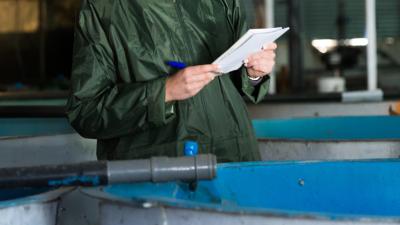
New technologies to improve health and safety performance
Discovering Safety joins forces with Safetytech Accelerator to build a Smarter Regulation Sandbox.
This page is approximately a 3 minute read
This page was published on

A new report ‘Occupational health and safety in the aquaculture sector – a global review’ commissioned by global safety charity Lloyd’s Register Foundation has revealed that accident and incident reporting is insufficient and lacks a standardised approach.
Authored by RS Standards*, the report looks at evidence for OH&S incidents in the global aquaculture industry as well as evidence for the effectiveness of OH&S interventions to reduce such incidents.
The report confirms that the granularity of reporting systems in many countries does not allow data extrapolation and ‘at best, reporting of incidents in the aquaculture industry are aggregated within agriculture /fisheries /forestry- type reported data’. Types of accidents /incidents are not reported sufficiently and there is no standardised approach for their reporting. Even when there is a mandate for OH&S reporting, access to this data was problematic.
Also highlighted is the lack of management /regulation governing small-scale aquaculture operations, which means there are big uncertainties on the exposure of workers on smaller-scale farms to OH&S hazards.
Tim Slingsby, Director of Skills and Education at Lloyd’s Register Foundation said: “As well as 20.5 million documented aquaculture workers globally, there are also a large number of undocumented workers in the informal work sector, particularly in Asia and Africa, who will be more vulnerable to poor work conditions and worker violations – and hence at increased risk of exposure to OH&S hazards. We need more data that’s reported accurately and consistently in order for effective interventions to be designed.”
The report categories OH&S hazards in aquaculture into six categories: safety, physical, chemical, biological, ergonomic, and psychosocial. The most common injuries are falls, blows from an object, net entanglement, pricks/cuts/punctures, high voltage exposures and needlestick injuries, while the most common occupational diseases and disorders are musculoskeletal disorders, respiratory symptoms and asthma, skin infections, dermatitis and urticaria. The wide range of prevalence suggests there is a good opportunity for interventions to reduce rates.
Tim added: “Comprehensive data of aquaculture OH&S is largely confined to commercial enterprises in wealthier countries, such as Norway, USA, Canada and Australia. A previous report from the Food and Agriculture Organization (FAO) in 2017 which reviewed the evidence on OH&S incidents in peer-reviewed and grey literature found that very few studies (3%) were reported from LMICs. As the report states, this leads to reporting bias so we’re not seeing an accurate global picture from the data available, especially when the majority of aquaculture workers are based in Asia.”
Looking at the effectiveness of interventions, the report identified seven higher-level indicators that influence the risk landscape of health and safety in aquaculture settings:
The report concludes with a call for a comprehensive framework for evaluating and reporting the current status of OH&S in aquaculture that can be applied consistently at country, regional and /or aquaculture systems level. Its development, says the report, ‘would require an international approach with multi-stakeholder and disciplinary inputs'.
Occupational health and safety in the aquaculture industry – a global review
Download the full report